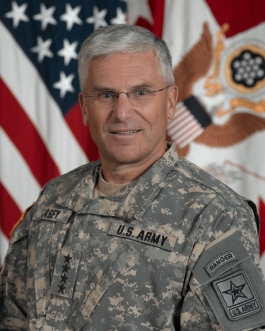Chief of Staff of the Army: Difference between revisions
imported>Howard C. Berkowitz (New page: {{subpages}} The United States '''Chief of Staff of the Army''' (CA) is the senior officer of the United States Army unless the Chairman of the Joint Chiefs of Staff or the [[Vice ...) |
imported>Howard C. Berkowitz m (typos; cut and paste is sinful.) |
||
| Line 1: | Line 1: | ||
{{subpages}} | {{subpages}} | ||
The United States '''Chief of Staff of the Army''' ( | The United States '''Chief of Staff of the Army''' (CSA) is the senior officer of the [[United States Army]] unless the [[Chairman of the Joint Chiefs of Staff]] or the [[Vice Chairman of the Joint Chiefs of Staff]] is an Army officer. He is appointed by the President and confirmed by the Senate, currently for a four-year term, and usually retires after that single term. | ||
A member of the [[Joint Chiefs of Staff]] (JCS), he does not directly command operational forces of the Army, which are under [[Unified Combatant Command]]s that report to the [[United States Secretary of Defense|Secretary of Defense]] and the [[President of the United States]]; the latter two constitute the [[National Command Authority]]. | A member of the [[Joint Chiefs of Staff]] (JCS), he does not directly command operational forces of the Army, which are under [[Unified Combatant Command]]s that report to the [[United States Secretary of Defense|Secretary of Defense]] and the [[President of the United States]]; the latter two constitute the [[National Command Authority]]. | ||
The CNO reports to the [[Secretary of the Army]], especially in matters such as Congressional relations, but has complex relationships with the [[Joint Chiefs of Staff]] and Secretary of Defense. While he does not have operational command over | The CNO reports to the [[Secretary of the Army]], especially in matters such as Congressional relations, but has complex relationships with the [[Joint Chiefs of Staff]] and Secretary of Defense. While he does not have operational command over army forces, he has enormous influence. | ||
He is assisted by the [[Vice Chief of Staff of the Army]]. | He is assisted by the [[Vice Chief of Staff of the Army]]. | ||
Revision as of 14:46, 26 June 2008
The United States Chief of Staff of the Army (CSA) is the senior officer of the United States Army unless the Chairman of the Joint Chiefs of Staff or the Vice Chairman of the Joint Chiefs of Staff is an Army officer. He is appointed by the President and confirmed by the Senate, currently for a four-year term, and usually retires after that single term.
A member of the Joint Chiefs of Staff (JCS), he does not directly command operational forces of the Army, which are under Unified Combatant Commands that report to the Secretary of Defense and the President of the United States; the latter two constitute the National Command Authority.
The CNO reports to the Secretary of the Army, especially in matters such as Congressional relations, but has complex relationships with the Joint Chiefs of Staff and Secretary of Defense. While he does not have operational command over army forces, he has enormous influence.
He is assisted by the Vice Chief of Staff of the Army.
Incumbent
General George W. Casey, Jr. became the 36th Chief of Staff, United States Army, on April 10th, 2007. His previous assignment was commanding Multi-National Force Iraq (MNF-I).
